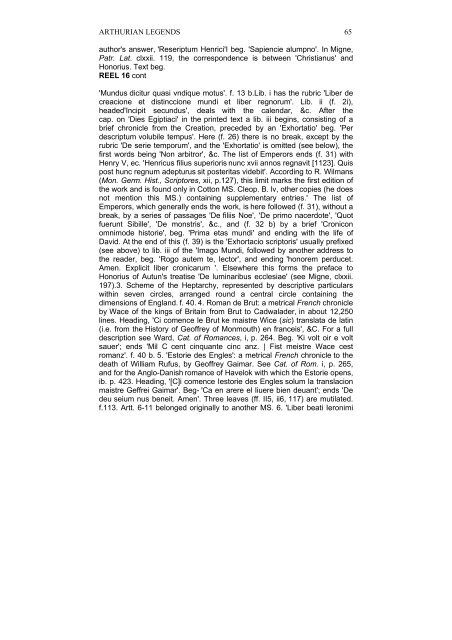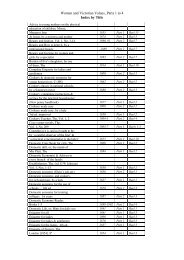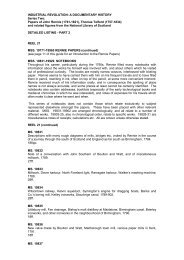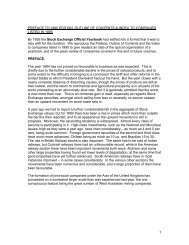arthurian legends 19 arthurian legends and the influence of french ...
arthurian legends 19 arthurian legends and the influence of french ...
arthurian legends 19 arthurian legends and the influence of french ...
You also want an ePaper? Increase the reach of your titles
YUMPU automatically turns print PDFs into web optimized ePapers that Google loves.
ARTHURIAN LEGENDS 65<br />
author's answer, 'Reseriptum Henrici'I beg. 'Sapiencie alumpno'. In Migne,<br />
Patr. Lat. clxxii. 1<strong>19</strong>, <strong>the</strong> correspondence is between 'Christianus' <strong>and</strong><br />
Honorius. Text beg.<br />
REEL 16 cont<br />
'Mundus dicitur quasi vndique motus'. f. 13 b.Lib. i has <strong>the</strong> rubric 'Liber de<br />
creacione et distinccione mundi et liber regnorum'. Lib. ii (f. 2i),<br />
headed'Incipit secundus', deals with <strong>the</strong> calendar, &c. After <strong>the</strong><br />
cap. on 'Dies Egiptiaci' in <strong>the</strong> printed text a lib. iii begins, consisting <strong>of</strong> a<br />
brief chronicle from <strong>the</strong> Creation, preceded by an 'Exhortatio' beg. 'Per<br />
descriptum volubile tempus'. Here (f. 26) <strong>the</strong>re is no break, except by <strong>the</strong><br />
rubric 'De serie temporum', <strong>and</strong> <strong>the</strong> 'Exhortatio' is omitted (see below), <strong>the</strong><br />
first words being 'Non arbitror', &c. The list <strong>of</strong> Emperors ends (f. 31) with<br />
Henry V, ec. 'Henricus filius superioris nunc xvii annos regnavit [1123]. Quis<br />
post hunc regnum adepturus sit posteritas videbit'. According to R. Wilmans<br />
(Mon. Germ. Hist., Scriptores, xii, p.127), this limit marks <strong>the</strong> first edition <strong>of</strong><br />
<strong>the</strong> work <strong>and</strong> is found only in Cotton MS. Cleop. B. lv, o<strong>the</strong>r copies (he does<br />
not mention this MS.) containing supplementary entries.' The list <strong>of</strong><br />
Emperors, which generally ends <strong>the</strong> work, is here followed (f. 31), without a<br />
break, by a series <strong>of</strong> passages 'De filiis Noe', 'De primo nacerdote', 'Quot<br />
fuerunt Sibille', 'De monstris', &c., <strong>and</strong> (f. 32 b) by a brief 'Cronicon<br />
omnimode historie', beg. 'Prima etas mundi' <strong>and</strong> ending with <strong>the</strong> life <strong>of</strong><br />
David. At <strong>the</strong> end <strong>of</strong> this (f. 39) is <strong>the</strong> 'Exhortacio scriptoris' usually prefixed<br />
(see above) to lib. iii <strong>of</strong> <strong>the</strong> 'Imago Mundi, followed by ano<strong>the</strong>r address to<br />
<strong>the</strong> reader, beg. 'Rogo autem te, lector', <strong>and</strong> ending 'honorem perducet.<br />
Amen. Explicit liber cronicarum '. Elsewhere this forms <strong>the</strong> preface to<br />
Honorius <strong>of</strong> Autun's treatise 'De luminaribus ecclesiae' (see Migne, clxxii.<br />
<strong>19</strong>7).3. Scheme <strong>of</strong> <strong>the</strong> Heptarchy, represented by descriptive particulars<br />
within seven circles, arranged round a central circle containing <strong>the</strong><br />
dimensions <strong>of</strong> Engl<strong>and</strong>. f. 40. 4. Roman de Brut: a metrical French chronicle<br />
by Wace <strong>of</strong> <strong>the</strong> kings <strong>of</strong> Britain from Brut to Cadwalader, in about 12,250<br />
lines. Heading, 'Ci comence le Brut ke maistre Wice (sic) translata de latin<br />
(i.e. from <strong>the</strong> History <strong>of</strong> Ge<strong>of</strong>frey <strong>of</strong> Monmouth) en franceis', &C. For a full<br />
description see Ward, Cat. <strong>of</strong> Romances, i, p. 264. Beg. 'Ki volt oir e volt<br />
sauer'; ends 'Mil C cent cinquante cinc anz. | Fist meistre Wace cest<br />
romanz'. f. 40 b. 5. 'Estorie des Engles': a metrical French chronicle to <strong>the</strong><br />
death <strong>of</strong> William Rufus, by Ge<strong>of</strong>frey Gaimar. See Cat. <strong>of</strong> Rom. i, p. 265,<br />
<strong>and</strong> for <strong>the</strong> Anglo-Danish romance <strong>of</strong> Havelok with which <strong>the</strong> Estorie opens,<br />
ib. p. 423. Heading, '[C]i comence Iestorie des Engles solum la translacion<br />
maistre Geffrei Gaimar'. Beg- 'Ca en arere el liuere bien deuant'; ends 'De<br />
deu seium nus beneit. Amen'. Three leaves (ff. II5, ii6, 117) are mutilated.<br />
f.113. Artt. 6-11 belonged originally to ano<strong>the</strong>r MS. 6. 'Liber beati Ieronimi







